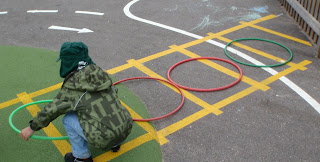Enclosure is all about 'insideness'. For example children may like to wrap things, cover things, fill empty space or enclose something or themselves.
 |
| This girl builds with blocks and encloses herself. |
A child may begin to show evidence of having an enclosure schema from an early age. They may put toys inside the washing machine or small stones inside their pockets. As a parent this can be rather frustrating!
 |
This girl uses a scarf and a necklace to enclose
her neck. Some children wear lots of bangles to enclose their arm. |
Children who are following a enclosure schema are developing their understanding of capacity and volume. These concepts are important in the development of mathematical and scientific knowledge.
Envelopment Schema
A child who is fascinated with wrapping themselves up in materials and likes to cover their hands and body with paint are following an envelopment schema. These children enjoy exploring 'under' and 'insideness'. They like to fill bags, wrap up parcels, dress up, bury things - including their hands and feet - play inside tents and tunnels.
Once they have painted a picture they are more likely to cover it over completely or fold it up into a tiny piece then put it in their pocket.
Exploring an enveloping schema can help children to develop an understanding of space and size, volume and capacity. During their play envelopers develop ideas about estimating size and predicting - 'what fits inside this?' and 'How much paper will I need to wrap this box?'
 |
This four year old decides to paint the window. It is completely covered with red paint.
Another child decided to paint the inside of a bowl. He then placed a box inside the painted bowl before painting the inside of the box. |










